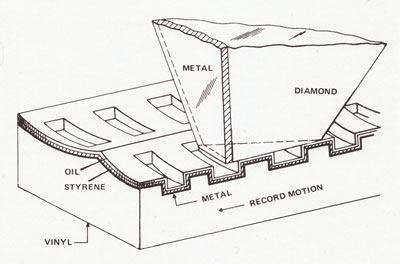
 |
Search | FAQ | US Titles | UK Titles | Memories | VaporWare | Digest | |||||||
| GuestBook | Classified | Chat | Products | Featured | Technical | Museum | ||||||||
| Downloads | Production | Fanfares | Music | Misc | Related | Contact | ||||||||
| CED in the History of Media Technology | ||||||||||||||

1977 was the last year RCA conducted research on metallized dielectric VideoDiscs. The above cross section shows the final structure of these discs. The basal mass of the disc was clear vinyl coated with a very thin layer of metal. On top of this was a thin layer of insulating styrene and a coating of oil for lubrication. RCA experimented with various metal coatings over the development years. Initially the layer was aluminum, but this was found to be too grainy. Evaporated gold produced good images, but was too expensive. Copper produced a cost-effective quality image, but under certain conditions the copper would corrode, despite the protective styrene layer. The final metallized discs had a bimetal sandwich layer consisting of copper underneath and corrosion-resistant iconel on top.
In 1977 the stylus was composed of diamond with a thin titanium electrode sputtered on the trailing edge. During the prior development years RCA had used a sapphire stylus with a sputtered tantalum electrode. But as the groove density steadily increased, the smaller sapphire styli thus required began to break. In 1977 the production groove density of 9541 grooves per inch was achieved, allowing a two hour movie to be stored on a single disc.